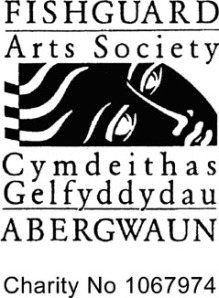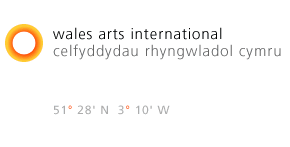
A Project supported by
Wales Arts International
Project report: Glenn Ibbitson
Initial Proposal: submitted by Gaynor McMorrin, Chair, FAS
“We are taking an exhibition of 50 small works and accompanying DVD by members of Fishguard Arts Society to the Arton Gallery, Kyoto with a view to establishing further links and collaborative projects. The exhibition will run from the 7th -19th April 2009
We are asking for the plane fare, subsistence and travel pass for one of our members, painter and film maker, Glenn Ibbitson, who set up the initial “Little Jewels” small works Exhibition for the Society in Fishguard. The Society would be benefit from having him involved on the ground in Kyoto.”
FAS little jewels was a direct response to a small exhibition space, that of Fishguard Town Hall Gallery. We could either present a few works by a select section of our membership, or represent a wider membership with smaller pieces. As FAS prides itself on resisting the development of hierarchies based on background or qualifications, we opted for the second option. We chose to present a show using CD cases as frames.
The jewel case is ubiquitous and democratic; it provides the perfect, temporary and low cost display frame for artwork. Its use promoted a satisfying uniformity of presentation.
Working on this scale can present a real challenge to both professional and amateur members, but it was met on this occasion with high quality work. working on this size actually threw forward members whose work had hitherto been eclipsed by more established artists…Particular ingenuity was displayed by our sculptors and ceramicists.
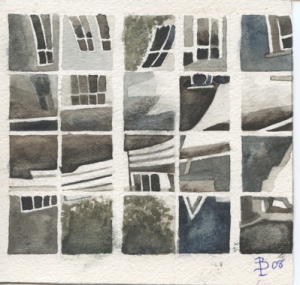

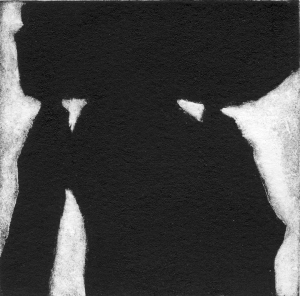

A catalogue was produced. This was issued in the form of a compact disc. All exhibited works were reproduced as high quality Jpegs. The response by both artists and public was sufficiently positive to encourage a follow-up show in the future.
Gaynor McMorrin has developed several contacts on her previous visits to Japan and she felt that a venue in Japan would promote the art of West Wales on the international stage. Natsuki Kurimoto was our connection with the exhibition venue in Kyoto.
Natsuki Kurimoto is an internationally acclaimed laquered wood fine artist/craftsman [categorisation of disciplines in Japanese art are rather meaningless] The lacquer medium is created from the raw sap of the Japanese urushi tree (t. verniciflua), and is then filtered and colored before application. Urushi has been an important medium in Japan since ancient times. In producing early Buddhist sculpture in Japan, urushi was mixed with ground fired and unfired clays and applied over a moulded form comprising layers of hemp cloth to form complex figures. This process is known in Japan as kanshitsu. Natsuki has made extensive use of this technique in his large scale sculptures and installations. He is currently Associate Professor in the department Fine Arts and full-time lecturer in the Department of Lacquer Crafts at Kyoto City University of Arts.
Our venue, negotiated byNatsuki, was the Arton Art Gallery. It is housed within the elegant bichromatic South Wing of the Kyoto Museum, formerly the Bank of Japan, Kyoto branch. This space within the museum is leased to private galleries. The Arton Consists of an exhibition space and a shop. It provided adequate space for our exhibition of about 50 works. A DVD player was installed to present a looped film, devoting a minute to the work or studio practice of each exhibitor. In keeping with the style of the show, a comprehensive catalogue of work was produced in CD form.
Sales list: Twelve works were sold, ranging in price from £30-£250.
Gallery owner Mr. Kimura considered the venture to be a success. He invited proposals from us for future shows.

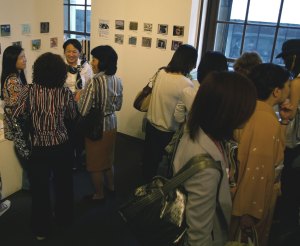
Contacts and Opportunities for Future Collaboration
St David’s Society, Kansai:
Correspondence had commenced with this Osaka-based society prior to our journey our contact was the secretary, Chikako Hirono.
From ms. Hirono: Thursday, 12 March, 2009, 2:38 AM
“Hello again.
the Kansai St David’s Society would like to invite you and your fellow artists to our gathering during your stay in Japan. We organize a picnic at a park in Osaka, not only for St David’s Society but for other Britain-related groups in Osaka area every year. So I wonder if you could join the picnic if I set the date at your convenience? How about Sunday 5th?”
St. David’s Society Japan is a non-profitable friendship society for the Welsh, those with Welsh ancestry or simply any nationalities with an interest in Wales, its culture and the Welsh language. Previous guests of the society have included Catherine Jenkins, The society supports events that promote cultural ties between Japan and Wales and also fosters active links with other Wales-related bodies and societies. We enjoyed a picnic with society members on the 5th, in the grounds of Osaka Castle. Our hosts were typically considerate and engaging. Those present included a translator, information technologists, a fashion designer, retired businessmen. Ages ranged from early 20’s to mid 70’s. They were instrumental in advertising our event. Chikako posted information on the website.
T h e r e w i l l b e a n a r t e x h i b i t i o n b y F i s h g u a r d A r t s S o c i e t y a t t h e
A r t o n A r t G a l l e r y i n K y o t o f r o m 7 A p r i l , T u e s d a y , t o 1 9 , S u n d a y .
” Fishguard A r t s S o c i e t y – T h e c o s m o s i n C D c a s e s – ”
h t t p : / / w w w . a r t o n – k y o t o . c o m / e v e n t s . p h p
D u r i n g t h e e x h i b i t i o n , 3 “W e l s h a r t i s t s f r o m t h e a r t s o c i e t y w i l l b e a t t h e g a l l e r y .”
We were delighted to welcome many of our new friends to the preview a week later.
Koie Ryoji:
We encountered this renowned fine art ceramicist purely by chance. His work occupies the interface of functional ceramics and fine art, freely exploring the two realms with a flexible attitude. Universal themes are explored through particularly catastrophic world events; Hiroshima, Chernobyl, the World Trade Centre. These provide departure-points for an extraordinary range of surface treatments from the indulgent to the austere, incorporating a masterful use of the ‘Oribe’ or copper glaze. He maintains contact with other potters and ceramicists by using their voluntary assistance on projects.
There is an opportunity here for potters who wish to tap into years of practical experience and collaborate with an artist of great breadth of vision.
Nishijin Textile Centre:
I had attempted to organise an appointment with the centre’s PR officer without success [there was no active contact link on the Nishijin website]. However, we were able to discuss proposals during our visit on Friday 4th. Although essentially a commercial outlet, There are production facilities on site and suitable project proposals from textile artists will be considered.
Kyoto International Manga Museum:
This appointment Thursday 9th April 2pm. was organised before our departure. Our appointment was with Tomoyuki Omote phd; our interview took place in the research department, aided by one of the department’s translators.
The Museum has direct links with Kyoto Seika University. Although the arts in Japan are not as distinctly categorised and separated as in the West, academics hold the same reservations about the Manga art form as they do here in UK.
The Art faculty covers
fine art, [oil, Japanese painting and sculpture]
materials expression [ceramics & textiles]
media arts [printmaking, video and media]
Manga occupies a separate faculty of 3 departments:
cartoon and comic art
animation
Manga production
In spite of this ‘cordon sanitaire’, the medium in all its hybridising forms and styles has immense potential for the fine artist; particularly those with enthusiasms for Pop Art and the wider popular visual culture.
Manga has a quantifiable Economic value – apparently, it accounts for 40% of publications in Japan excluding newspapers. It covers a wide range of themes: cartoons directed at children, romance, action, erotic/adult, even discourses on economics. Consequently, interest crosses class and age barriers. . The original consumers of the genre: teenagers when the phenomenon erupted, are now middle aged and close to, if not already, retired. The sloganeering tee-shirt and the business suit sit side by side on commuter trains and park benches at lunchtime reading their favourite titles.
Manga is a medium based on teamwork and collaboration. In order to meet their fortnightly deadlines, the magazines employ several artists on one strip. The typical model for Western comic strip production is storywriter, pencil artist and inker. The more
visually sophisticated Japanese titles may employ several artists, each with a specific field of specialism; figure, animal, landscape. The visual style may shift significantly from panel to panel across a page. Add to this team a calligrapher. The results can be quite beautiful. These strips provide a marvellous training ground for the production of storyboards for cinema and television.
Potential avenues of study
1 History: only recently appeared on the West’s cultural radar, but in fact Manga predates the superhero comic influence imported by occupying allied forces after WW2.
2 The styles of Manga: Just what is pure Manga? Hybridisation and the influence of Western culture, seen at its most distressing in the familiar wide-eyed, silicone-implanted, adolescent female protagonist.
3 Fine art antecedents and the essential Japanese aesthetic: common ground with former preoccupation with “the Floating World”.
4 social and psychological implications: manga as an outlet for darkest sexual and destructive urges in a society where crime rates are still comparatively low for such a highly urbanised, industrially developed nation. Pornography and censorship issues.
There are match funding opportunities for such study. With their fully-developed links with Seiko University, the Museum are willing to receive proposals and will liaise on our artist/artists behalf to link with a suitable partner in the Manga faculty. If the project is more suitable for development within the Fine Art faculty, they will direct it to a contact there. The Asia-Europe Foundation have organised collaborative Manga-based projects in the past. Its experience has now provided a most satisfactory funding model. Any proposal from us in the future, where funding for our artist/artists is available, will be matched by the Japanese authorities for their partner.
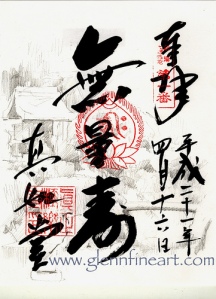
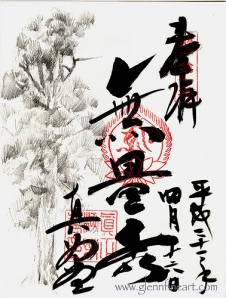
Temple of Shinnyo Do:
The Buddhist temples of Japan are tended by monks who are noted for their calligraphic skills. Visitors can have posters or guide books stamped, signed and dated in beautiful script. Having produced some drawings in the grounds of Shinnyo-Do, I was intrigued to see what these monks would make of my invitation to them to write across these sketches. Two monks offered up their skills with enthusiasm; one attempted to work around the drawing, according the image more respect than I had wished for.. the other calligrapher wrote across drawing before him, thereby achieving a more satisfactory integration of image and lettering.
Buddhist temples have their finger on the commercial pulse. They are well known for providing temporary accommodation for travellers. The personnel of Shinnyo-Do are no strangers to creative collaboration. In 2002 JR-Tokai (Central Japan Railway Company) used Shinnyo-Do in a TV commercial and a tourism promotion poster, “Soda Kyoto, Ikou (so, I will go to Kyoto)”. An approach from an artist or filmmaker with an interest in either religious art and architecture, or an enthusiasm for the calligraphic arts is likely to be considered positively.
An obligatory diversion: Hiroshima
I believe that if there be such a thing, a nation’s essential character can more easily be identified by looking at the way it deals with its worst tragedy. Aberfan, the Somme, Auschwitz, Gettysburg. Japan presents two sites which should forever focus international shame; Hiroshima and Nagasaki. Their similar ordeals were separated by just 3 days; I chose to visit Hiroshima. Virtually all the reminders of what happened at 8.15am on August 6th 1945 can be seen in one relatively small area of town. The former Industrial Promotion Hall [the A-Bomb Dome], the eternal flame of peace, the Cenotaph, ,the Burial mound, the Korean A-Bomb Memorial; all are viewable from the Aioi-bashi bridge. A visitor not reaching this point would have difficulty in uncovering evidence for the explosion elsewhere. This is a new city of quality high-rise architecture. Hiroshima is a city at ease with itself and its central position in the ongoing nuclear disarmament debate.
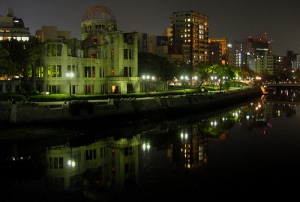
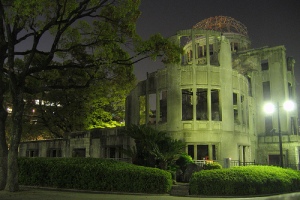
I arrived on a Sunday, when the public spaces were filled with happy groups of young people. Indeed, that afternoon’s demographic was overwhelmingly young; 15-40 as far as I could judge from appearance, behaviour and musical tastes being indulged. Their pleasures though, were occasionally and all too briefly thrown into stark relief by a very few sightings of elderly persons of a certain age; backs bowed forward and legs bowed out.. these are the Hibakusha, or survivors, and there are very few of them now…
The Peace Memorial Museum has a dignity and balance absent in some memorials of historical moment elsewhere. Analysis of decisions made by the Allied forces, justifications, alternatives, strategy, tactics and outcomes, are presented dispassionately, though the decision to monitor, rather than to treat, survivors is addressed with a sophistication which very nearly succeeds in camouflaging a deep and justifiable anger.
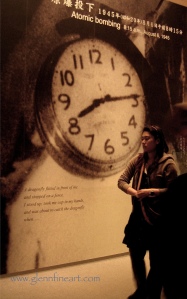
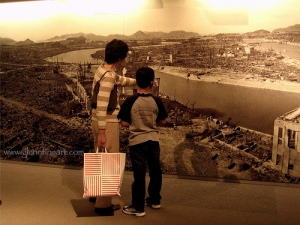
The columns of the main hall are decorated with facsimile letters sent by successive mayors of Hiroshima to their counterparts in cities worldwide, and Heads of State, encouraging nuclear disarmament. The position of Mayor of Hiroshima has become an honorary post as international ambassador for peace. Thankfully, the school parties are still coming to read these messages. Parents are still bringing their children to see the evidence of this wickedness; photographs and film of the devastation; collections of fingernails which began to curve sideways during that 1945 Autumn; stone steps rescued from demolished buildings, which preserve the etched shadows of vapourised human beings… Exactly what does one write in the visitors book of a museum at the end of such an essential and profoundly moving visit?
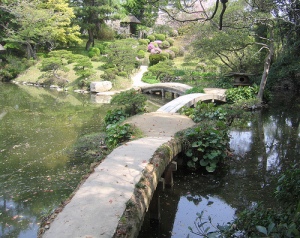
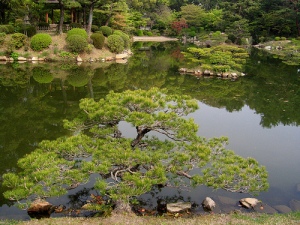
The following day I visited the beautiful Gardens of Shukkeien Painstakingly designed, but not symmetrically formalised. Its lakeside features; islands, trees and waterfalls, are miniaturised. This is a park scaled for the delight of children and those adults with a healthy sense of romance and whimsy. Herons were repairing their nests in the treetops, kingfishers keened low across the water. Oversized bees and Swallowtails flitted around the cherry blossoms. Idyllic. I then came across an information panel,
“A large number of survivors took refuge here immediately after the bombing, but died before receiving medical care. Their remains were interred within the garden”
Hiroshima is one of the most provocative places I have ever visited; stylish, vibrant; culturally and historically vital; moving beyond words..
Conclusion
I feel that our project remains incomplete. Thanks to the generous support of Wales Arts International, we have been able to provide Kyoto and the people of Kansai with a taste of the visual art being produced in West Wales.
Using Natsuki Kurimoto as our contact on the ground in Kyoto, our next project will bring a selection of artwork from Japan to a venue or venues in Wales. I am currently in discussion with two exhibitions organisers who have expressed an interest in this reciprocal exhibition.
We have developed several contacts, which should prove most useful to Welsh artists and craftspeople. The list of websites below provides significant information which may be helpful in shaping future projects.
The generous support for this project by Wales Arts International is greatly appreciated
Glenn Ibbitson
May 2009 http://www.glennfineart.com
Fishguard Arts Society: http://www.fishguardartssociety.org.uk
St. David’s Society, Japan http://cdsjapan.ninja-x.jp/
E-mail: cymruambythkansai-4stdavidssociety@yahoo.co.jp
Arton Art Gallery http://www.arton-kyoto.com/
E – m a i l : i n f o @ a r t o n – k y o t o . c o m
Kyoto International Manga Museum http://www.kyotomm.com/
Shinnyo-Do Temple : 82 Shinnyo-cho, Jodo-ji, Sakyo-ku, Kyoto City
Telephone : 075-771-0915
Koie Ryoji Studio: 2586 Iidahora Kamiyahagi-Cho Ena-City Gifu Japan
tel. 0573-48-3070 fax. 0573-48-3040
Natsuki Kurimoto: http://www.keikogallery.com/KurimotoNatsuki.html
Nishijin Textile Centre: http://www.nishijin.or.jp
E-mail:info@nishijin.jp Tel. 075-451-9231
Kyoto Seika University http://www.kyoto-seika.ac.jp/eng/
E-mail: ksuinted@kyoto-seika.ac.jp
